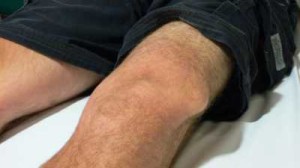Baker’s cyst is a tear in the cartilage of the knee or the arthritic joints that can lead to the accumulation of fluid at the back of the knee. There is tenderness, tightness, swelling and pressure felt at the back of the knee. The pain becomes severe when flexing or extending the knee or being active.
Baker’s cyst is also called popliteal cyst which is an issue with the joint of the knee such as arthritis or a tear in the cartilage. These two conditions cause the knee to produce plenty of fluids which leads to the development of Baker’s cyst.
Symptoms
- Presence of pain in the knee
- A swelling at the back of the knee and sometimes radiates to the leg
- Inability and stiffness in flexing the knee
- The symptoms become severe when standing for long periods of time.
Causes

The synovial fluid is a lubricating fluid that helps in swinging the leg smoothly and minimizes friction between parts of the knee that are mobile. Sometimes, the knee produces plenty of synovial fluid that causes the accumulation of fluid in the area found at the back of the knee which is known as popliteal bursa which can lead to the development of Baker’s cyst. This can happen due to an injury to the knee such as a tear in the cartilage and also inflammation of the joint of the knee like arthritis.
In some cases, a Baker’s cyst can burst and if it happens, it has similarities with the symptoms of blood clot which causes swelling, pain and redness in the calf. If this happens, seek medical help immediately.
Treatment
- Take plenty of rest especially the affected knee.
- Apply an ice pack around the cyst as soon as possible for 15-20 minutes at a time. Make the area warm to room temperature then apply again for another 15-20 minutes. The application of ice helps lessen the inflammation and swelling for the first 1-2 days after the injury of the affected area and also helps in minimizing pain.
- Another way is wrapping a bag of ice or frozen vegetables such as peas using a towel and then place over the affected knee. Just remember to avoid applying ice directly into the area to avoid aggravating the condition.
- Use a compression bandage such as an Ace wrap, trainer’s tape, brace or a piece of clothing around the affected area. The compression helps lessen the swelling of the affected area and also helps in stabilizing the knee. Avoid making the compression tight since this can cut off the blood circulation in the area.
- Elevate the affected leg to help minimize the swelling and helps return blood to the heart. When lying down, raise the leg above the level of the heart or even as high as possible without causing pain. If the leg cannot be raised, make it parallel to the ground.
- Another way is placing a couple of pillows under the legs when sleeping in order to keep them elevated.
- Take the prescribed over-the-counter pain medication such as ibuprofen and acetaminophen to minimize the swelling and pain.
